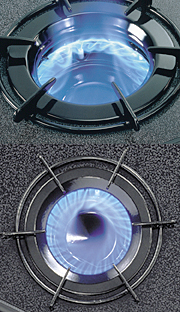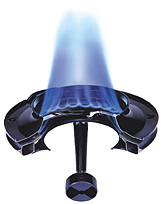1 Using the Rinnai Burner Hob
2 Rinnai Inner Flame Technology
3 Review:Rinnai 2-Burner Hob RB-2CG
Source: www.appliancedesign.com, October 28, 2003
Ignition/Burner Control: Whirly Burn

Rinnai gas cooktop (right) incorporates recessed, inner-flame burners into a Schott Ceran glass-ceramic panel to create an appliance that provides high-performance
Inner-flame burner improves heat transfer efficiency.

Cutaway view of Rinnai’s inner-flame burner shows how the individual flames coalesce and rise toward the center. When the cone of flame hits the bottom of a pan, it flows outward across the bottom to ensure even heat distribution and efficient heat transfer.
o o o
Appliance-maker Rinnai Corp., Nagoya, Japan, has turned burner design completely around with its inner-flame burner. Instead of shooting flames outward from the burner perimeter, as with a conventional burner, Rinnai’s inner-flame burner is ported so that flames shoot inward toward the center.
The purpose of the unusual design is to create a coherent, unified flame that rises under the center of a pan, then flows outward, bathing the entire bottom of the pan in flame. This approach heats the pan with greater uniformity and improves the efficiency of heat transfer from the flame to pan.
In addition to aiming the ports inward, two other design factors assist in shaping the flame. One is that the burner sits slightly below the surface of the cooktop, helping the individual flames to coalesce toward the center as they rise through a hole in the cooktop surface. Secondly, and more importantly, the burner ports are angled slightly on the horizontal plane. (See top view in lower photo.)
The effect of the flames shooting out an angle is to create a fiery vortex. The swirling flame is meant to accomplish two things. One, it assists in driving the flame outward across the bottom of the pan, helping to evenly bathe the pan bottom with flame. Two, the vortex creates a pressure drop that assists in drawing air in for combustion.
The large version of the inner-flame burner has 24 ports and delivers a maximum output of 15,872 BTUs/hr. The burners are lit by direct-spark ignition.
Rinnai originally intended the inner-flame burner to be installed into a metal panel cooktop. Instead, Rinnai began working with Schott Corp. to find a way to implement the novel burner into a Ceran surface panel.
Schott’s technical support staff worked closely with Rinnai to address a number of issues. One of the biggest was concern over how to protect the burner and other
Rinnai incorporated many of Schott’s design ideas in the final production model of the appliance.
The result was a unique appliance that successfully combines a novel, high-performance burner design and a convenient, easy-to-clean cooktop surface.
Schott says that the popularity of Ceran is growing in the Japanese market because the material’s cleanability is a big advantage in a region where cooking methods involve a lot of frying.
Rinnai says the cooktop with the inner-flame burners has been adopted by many Japanese cooking schools because the burner system is amenable to cooking different regional styles of meals, including Japanese, Chinese and French.
At this point in time, Rinnai has no plans to license the inner-flame burner technology to other appliance manufacturers. — R.J.B.
o o o
We found Fujioh Japan also makes gas hobs with inner flame burners. Is it the same as Rinnai's and did Rinnai license the technology to Fujioh?
Related Posts
1 Using the Rinnai Burner Hob
2 Rinnai Inner Flame Technology
3 Review:Rinnai 2-Burner Hob RB-2CG












0 comments:
Post a Comment
Hi, thanks for your comments. While I will strive to answer all your queries please be patient as I am overwhelmed at work.
Thanks for your understanding,
GreenCoal